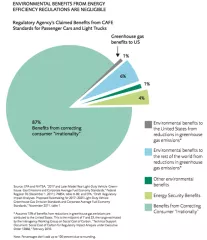- | Regulation Regulation
- | Policy Briefs Policy Briefs
- |
Overriding Consumer Preferences With Energy Regulation
Criticisms and Responses
In the recent Mercatus Center study, “Overriding Consumer Preferences with Energy Regulation,” Ted Gayer, co-director of the Economic Studies program at the Brookings Institution, and W. Kip Viscusi, University Distin- guished Professor of Law, Economics, and Management at Vanderbilt, examined the economic justification for recent U.S. energy regulations proposed by the U.S. Department of Energy, the U.S. Department of Transportation, and the U.S. Environmental Protection Agency (EPA). The study found that the energy-efficiency standards have a relatively minor effect on greenhouse-gas emissions, and—per the regulating agencies’ own estimates—cannot pass cost-benefit analyses based on their environmental benefits alone. To justify these regulations, the agencies relied on estimated benefits derived from correcting consumer “irrationality.”
In the recent Mercatus Center study, “Overriding Consumer Preferences with Energy Regulation,” Ted Gayer, co-director of the Economic Studies program at the Brookings Institution, and W. Kip Viscusi, University Distinguished Professor of Law, Economics, and Management at Vanderbilt, examined the economic justification for recent U.S. energy regulations proposed by the U.S. Department of Energy, the U.S. Department of Transportation, and the U.S. Environmental Protection Agency (EPA). The study found that the energy-efficiency standards have a relatively minor effect on greenhouse-gas emissions, and—per the regulating agencies’ own estimates—cannot pass cost-benefit analyses based on their environmental benefits alone. To justify these regulations, the agencies relied on estimated benefits derived from correcting consumer “irrationality.”
Below, the authors address several misconceptions about the study’s findings.
CRITICS ARGUE THAT THE STUDY IS AN ATTACK MEANT TO UNDERMINE GOVERNMENT’S ATTEMPTS TO ADDRESS SOCIETY’S PROBLEMS
Long-standing guidelines issued by the Office of Management and Budget (OMB) require regulatory agencies to perform benefit-cost analysis (BCA) when considering new regulations or changes to existing regulations. Our research examined the economic justifications provided by three agencies for a set of new energy-efficiency regulations (current energy-efficiency regulations were beyond the study’s scope).
The study found that the majority of the benefits claimed for these regulations were derived from correcting so-called consumer “irrationality.” In a departure from OMB standards for conducting benefit-cost analyses, the agencies claimed that consumers and firms make irrational purchasing decisions if energy efficiency is not the primary criterion when purchasing certain products. Thus, the agencies claim, by correcting this mistake, the regulations create benefits for consumers and firms by limiting choices to only those products that meet the agencies’ standards.
The regulatory impact analyses examined in this study contain virtually no empirical evidence to support the agencies’ consumer “irrationality” proposition.
The analytical exceptions that the agencies take to achieve a nearly exclusive focus on energy efficiency is evidence of what Supreme Court Justice Stephen Breyer calls tunnel vision—a “classic administrative disease” in which agencies push “a single goal too far, to the point where it brings about more harm than good.”1
CRITICS DISPUTE THAT THESE ENERGY-EFFICIENCY STANDARDS HAVE NEGLIGIBLE ENVIRONMENTAL BENEFITS
Notwithstanding the stated objective to reduce environmental pollution, including greenhouse-gas emissions, the agencies’ own estimates show that the environmental benefits are minor, and the costs of the energy-efficiency regulations outweigh the estimated environmental benefits.
If anything, even the modest environmental benefits are overstated because they are based on projected benefits to the world—not just to citizens of the United States.This appears to be the first time the United States government has employed this type of benefits measure.
According to well-established analysis standards, the value of a regulation’s benefits is based on the willingness of U.S. citizens to pay for those benefits. The “worldwide” benefits approach assumes that U.S. citizens are willing to pay the same for benefits to other countries as they would for benefits to the United States. The agencies provide no evidence that such an assumption is valid.
CRITICS ARGUE THAT ENERGY-EFFICIENCY STANDARDS DO NOT RESTRICT CONSUMER CHOICE
The only way these energy-efficiency regulations pass a benefit-cost analysis (BCA)—as required by OMB guidelines—is if the agency conducting the analysis assumes that restricting consumer choice actually benefits consumers and firms. The assumption that consumers and firms (but not the regulators) are unable to make sound choices is counter to economic literature on public choice and consumer and firm behavior—and is also counter to OMB guidelines.
Critics are right in pointing out that, even when the standards take effect, consumers will often still have the option to buy the same car models as before. What they fail to note is that the energy-efficiency compliant models will cost consumers on average an additional $1,946, according to EPA estimates.2 If consumers lack the funds to cover the added upfront cost of the car, their choices are constrained—they will have to delay their purchase, opt for a cheaper model, or forgo some of the options they want (e.g., side-air bags, rearview camera).
CRITICS ARGUE THAT CONSUMER SAVINGS FROM ENERGY-EFFICIENCY STANDARDS SHOULD BE COUNTED AS BENEFITS
Energy-efficiency standards restrict consumer choice and force consumers and businesses to put energy efficiency above other concerns, such as product safety, reliability, size, etc. Limited choice is a cost, not a benefit to consumers. Agencies ought to count it as such.


